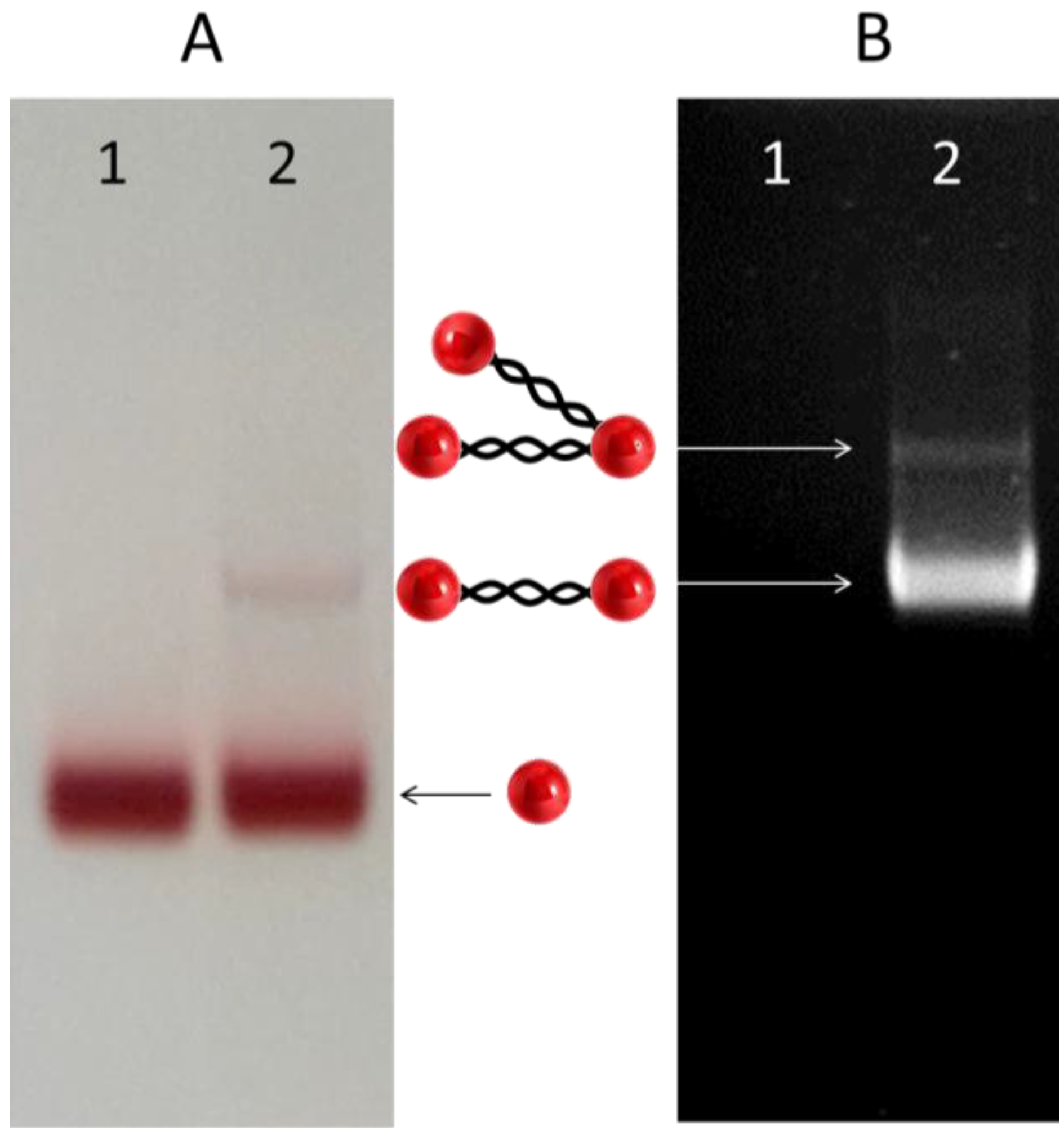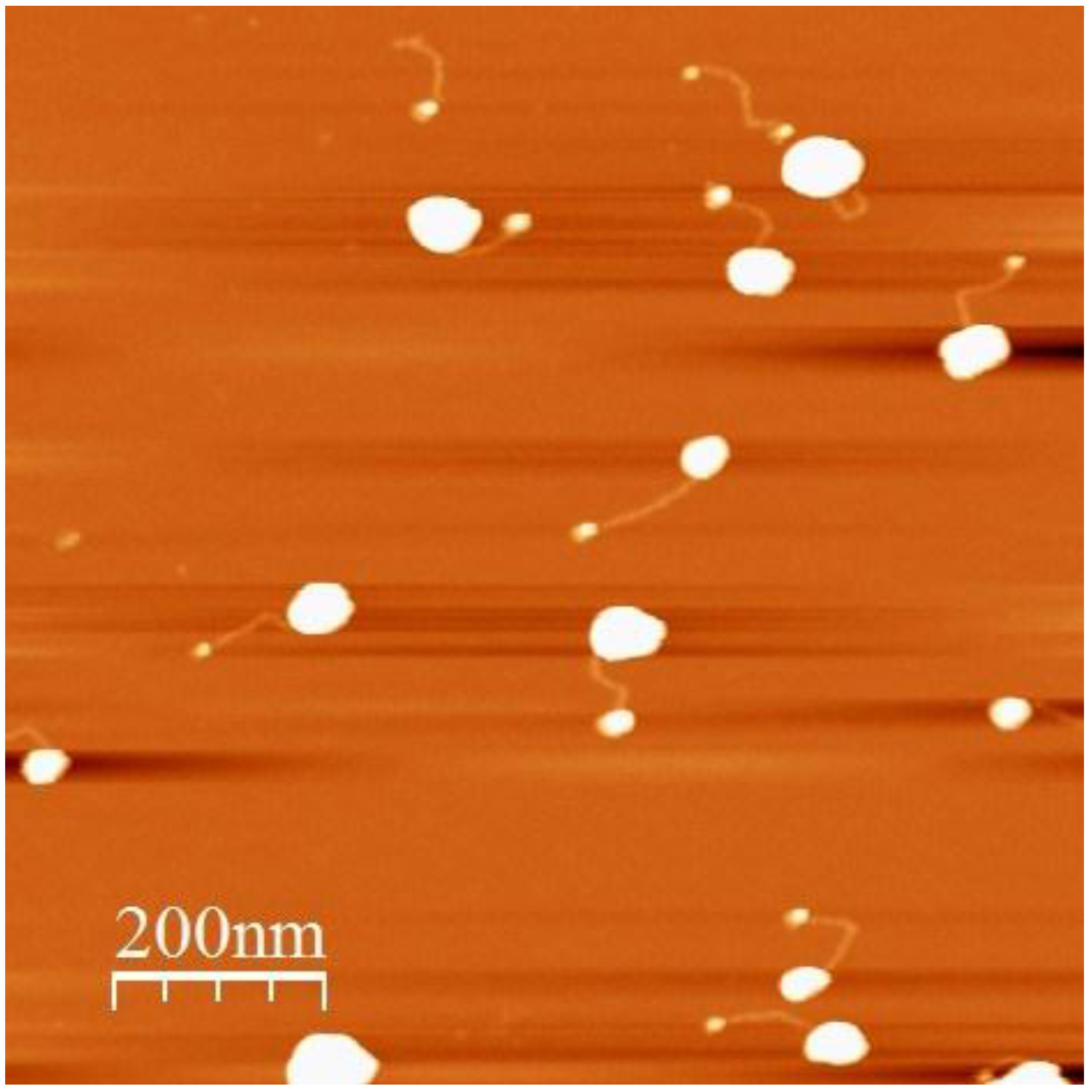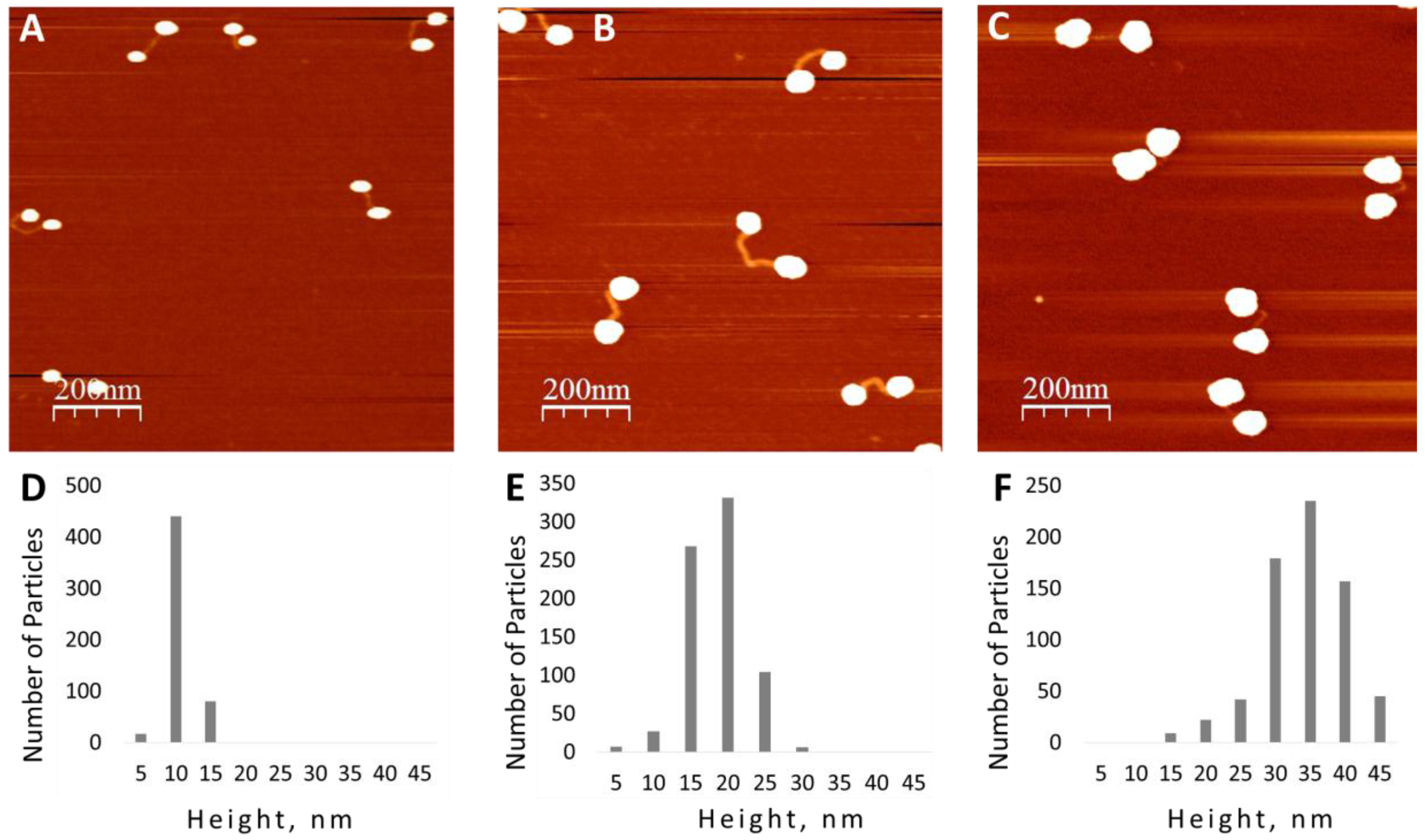Preparation, Characterization and Manipulation of Conjugates between Gold Nanoparticles and DNA
Abstract
:1. Introduction
2. Results and Discussion
2.1. Synthesis, Purification and Atomic Force Microscopy (AFM) Characterization of Dumbbell-Shaped DNA–Gold Nanoparticle (GNP) Conjugates
2.2. Enlargement of GNPs in the Conjugates
3. Materials and Methods
3.1. Materials
3.2. Oligonucleotide Purification
3.3. Enzymatic Synthesis of DNA
3.4. Synthesis of GNPs
3.5. Synthesis of DNA-GNP Conjugates
3.6. Atomic Force Microscopy
4. Conclusions
Supplementary Materials
Acknowledgments
Author Contributions
Conflicts of Interest
Abbreviations
References
- Mirkin, C.A.; Letsinger, R.L.; Mucic, R.C.; Storhoff, J.J. A DNA-based method for rationally assembling nanoparticles into macroscopic materials. Nature 1996, 382, 607–609. [Google Scholar] [CrossRef] [PubMed]
- Alivisatos, A.P.; Johnsson, K.P.; Peng, X.; Wilson, T.E.; Loweth, C.J.; Bruchez, M.P.; Schultz, P.G. Organization of ‘nanocrystal molecules’ using DNA. Nature 1996, 382, 609–611. [Google Scholar] [CrossRef] [PubMed]
- Loweth, C.J.; Caldwell, W.B.; Peng, X.; Alivisatos, A.P.; Schultz, P.G. DNA-Based Assembly of Gold Nanocrystals. Angew. Chem. Int. Ed. 1999, 38, 1808–1812. [Google Scholar] [CrossRef]
- Claridge, S.A.; Alivisatos, A.P. Pyramidal Chiral Groupings of Gold Nanocrystals Assembled Using DNA Scaffolds. J. Am. Chem. Soc. 2009, 131, 8455–8459. [Google Scholar]
- Fan, J.A.; He, Y.; Bao, K.; Wu, C.; Bao, J.; Schade, N.B.; Manoharan, V.N.; Shvets, G.; Nordler, P.; Liu, D.R.; Capasso, F. DNA-Enabled Self-Assembly of Plasmonic Nanoclusters. Nano Lett. 2011, 11, 4859–4864. [Google Scholar] [CrossRef] [PubMed]
- Aldaye, F.A.; Sleiman, H.F. Sequential self-assembly of a DNA hexagon as a template for the organization of gold nanoparticles. Angew. Chem. Int. Ed. 2006, 45, 2204–2209. [Google Scholar] [CrossRef] [PubMed]
- Aldaye, F.A.; Sleiman, H.F. Dynamic DNA templates for discrete gold nanoparticle assemblies: Control of geometry; modularity; write/erase structural switching. J. Am. Chem. Soc. 2007, 129, 4130–4131. [Google Scholar] [CrossRef] [PubMed]
- Zheng, J.; Constantinou, P.E.; Micheel, C.; Alivisatos, A.P.; Kiehl, R.A.; Seeman, N.C. Two-dimensional nanoparticle arrays show the organizational power of robust DNA motifs. Nano Lett. 2006, 6, 1502–1504. [Google Scholar] [CrossRef] [PubMed]
- Schreiber, R.; Santiago, I.; Ardavan, A.; Turberfield, A.J. Ordering Gold Nanoparticles with DNA Origami Nanoflowers. ACS Nano 2016. Epub ahead of print. [Google Scholar] [CrossRef] [PubMed]
- Gür, F.N.; Schwarz, F.W.; Ye, J.; Diez, S.; Schmidt, T.L. Toward Self-Assembled Plasmonic Devices: High-Yield Arrangement of Gold Nanoparticles on DNA Origami Templates. ACS Nano 2016, 10, 5374–5382. [Google Scholar] [CrossRef] [PubMed]
- Borovok, N.; Gillon, E.; Kotlyar, A. Synthesis Assembly of Conjugates Bearing Specific Numbers of DNA Strs per Gold Nanoparticle. Bioconjug. Chem. 2012, 23, 916–922. [Google Scholar] [CrossRef] [PubMed]
- Lim, D.K.; Jeon, K.S.; Kim, H.M.; Nam, J.M.; Suh, Y.D. Nanogap-engineerable Raman-active nanodumbbells for single-molecule detection. Nat. Mater. 2010, 9, 60–67. [Google Scholar] [CrossRef] [PubMed]
- Zikich, D.; Borovok, N.; Molotsky, T.; Kotlyar, A. Synthesis AFM characterization of poly(dG)-poly(dC)-gold nanoparticle conjugates. Bioconjug. Chem. 2010, 21, 544–547. [Google Scholar] [CrossRef] [PubMed]
- Yang, X.; Wang, X.-B.; Vorpagel, E.R.; Wang, L.S. Direct experimental observation of the low ionization potentials of guanine in free oligonucleotides by using photoelectron spectroscopy. Proc. Natl. Acad. Sci. USA 2004, 101, 17588–17592. [Google Scholar] [CrossRef] [PubMed]
- Hennig, D.; Starikov, E.B.; Archilla, J.F.R.; Palmero, F. Charge transport in poly(dG)-poly(dC) poly(dA)-poly(dT) DNA polymers. J. Biol. Phys. 2004, 30, 227–238. [Google Scholar] [CrossRef] [PubMed]
- Kotlyar, A.B.; Borovok, N.; Molotsky, T.; Fadeev, L.; Gozin, M. In vitro synthesis of uniform poly(dG)-poly(dC) by Klenow exo- fragment of polymerase I. Nucleic Acids Res. 2005, 33, 525–535. [Google Scholar] [CrossRef] [PubMed]
- Assefa, Z.; Forward, J.M.; Grant, T.A.; Staples, R.J.; Hanson, B.E.; Mohamed, A.A.; Fackler, J.P., Jr. Three-coordinate; luminescent; water-soluble gold(I) phosphine complexes: Structural characterization photoluminescence properties in aqueous solution. Inorganica Chim. Acta 2003, 352, 31–45. [Google Scholar] [CrossRef]
- De Pablo, P.J.; Moreno-Herrero, F.; Colchero, J.; Gomez Herrero, J.; Herrero, P.; Baro, A.M.; Ordejon, P.; Soler, J.M.; Artacho, E. Absence of dc-conductivity in lambda-DNA. Phys. Rev. Lett. 2000, 85, 4992–4995. [Google Scholar] [CrossRef] [PubMed]
- Storm, A.; Van Noort, J.; De Vries, S.; Dekker, C. Insulating behavior for DNA molecules between nanoelectrodes at the 100 nm length scale. Appl. Phys. Lett. 2001, 79, 3881–3883. [Google Scholar] [CrossRef]
- Porath, D.; Bezryadin, A.; De Vries, S.; Dekker, C. Direct measurement of electrical transport through DNA molecules. Nature 2000, 403, 635–638. [Google Scholar] [CrossRef] [PubMed]
- Kasumov, A.Y.; Kociak, M.; Gueron, S.; Reulet, B.; Volkov, V.; Klinov, D.; Bouchiat, H. Proximity-induced superconductivity in DNA. Science 2001, 291, 280–282. [Google Scholar] [CrossRef] [PubMed]
- Eidelshtein, G.; Kotlyar, A.; Hashemi, M.; Gurevich, L. Aligned deposition electrical measurements on single DNA molecules. Nanotechnology 2015, 26, 475102. [Google Scholar] [CrossRef] [PubMed]
- Kotlyar, A. Synthesis of long DNA-based nanowires. Methods Mol. Biol. 2011, 749, 115–140. [Google Scholar] [PubMed]
- Turkevich, J.; Stevenson, P.C.; Hillier, J. A study of the nucleation growth processes in the synthesis of colloidal gold. Discuss. Faraday Soc. 1951, 11, 55–75. [Google Scholar] [CrossRef]
- Horcas, I.; Fernez, R.; Gomez-Rodriguez, J.M.; Colchero, J.; Gomez-Herrero, J.; Baro, A.M. WSXM: A software for scanning probe microscopy a tool for nanotechnology. Rev. Sci. Instrum. 2007, 78, 013705. [Google Scholar] [CrossRef] [PubMed]




© 2016 by the authors; licensee MDPI, Basel, Switzerland. This article is an open access article distributed under the terms and conditions of the Creative Commons Attribution (CC-BY) license (http://creativecommons.org/licenses/by/4.0/).
Share and Cite
Eidelshtein, G.; Fattal, M.; Avishai, G.; Kempinski, B.; Giannini, C.; Kotlyar, A. Preparation, Characterization and Manipulation of Conjugates between Gold Nanoparticles and DNA. Nanomaterials 2016, 6, 167. https://doi.org/10.3390/nano6090167
Eidelshtein G, Fattal M, Avishai G, Kempinski B, Giannini C, Kotlyar A. Preparation, Characterization and Manipulation of Conjugates between Gold Nanoparticles and DNA. Nanomaterials. 2016; 6(9):167. https://doi.org/10.3390/nano6090167
Chicago/Turabian StyleEidelshtein, Gennady, Moran Fattal, Gavriel Avishai, Benjamin Kempinski, Clelia Giannini, and Alexander Kotlyar. 2016. "Preparation, Characterization and Manipulation of Conjugates between Gold Nanoparticles and DNA" Nanomaterials 6, no. 9: 167. https://doi.org/10.3390/nano6090167
APA StyleEidelshtein, G., Fattal, M., Avishai, G., Kempinski, B., Giannini, C., & Kotlyar, A. (2016). Preparation, Characterization and Manipulation of Conjugates between Gold Nanoparticles and DNA. Nanomaterials, 6(9), 167. https://doi.org/10.3390/nano6090167







